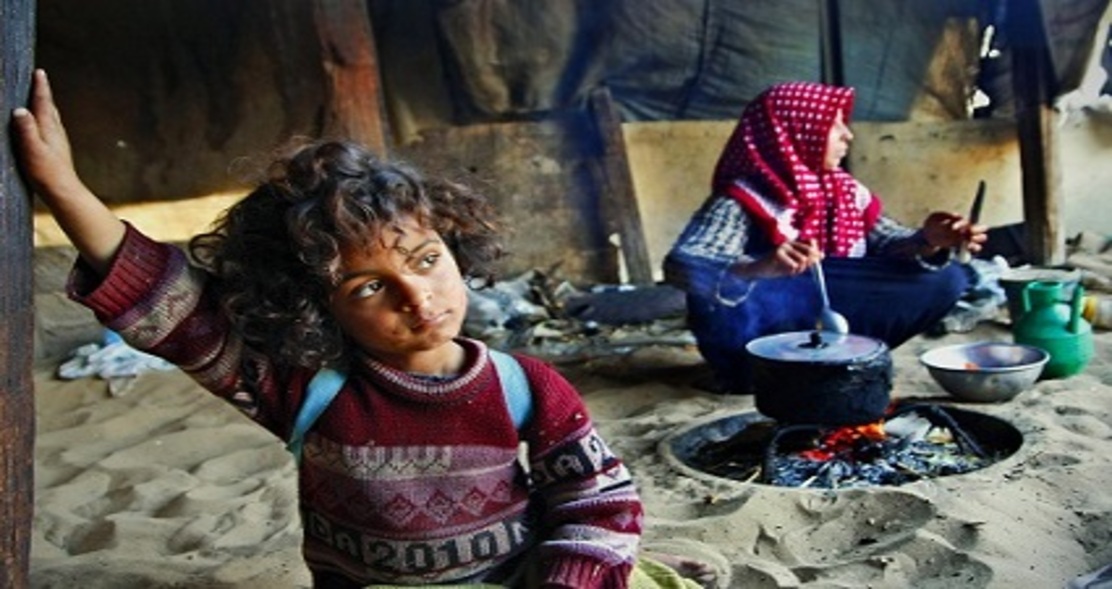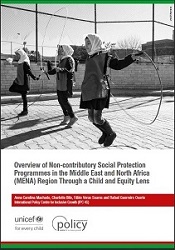Social Protection: New study addresses the needs of refugees and IDPs to fight child poverty in the MENA region

Photo by: IPC-IG/Eman Mohammed/Jabalia refugee camp northern Gaza strip.
by Júlia Matravolgyi, Communications Intern*
Brasilia, 24 May, 2018 - In addition to facing difficulties inherent to migration processes, refugees and internally displaced persons (IDPs) also find themselves in a vulnerable position regarding social protection programmes. As non-nationals, refugees often not eligible for social protection programmes in other countries.Similarly, IDPs often loose access to benefits due to the lack of portability of benefits. This is a global human rights issue: according to te UN Refugee Agency (UNHCR), more than 67.75 million people were classified as “persons of concern” in 2016, most of them children.
The new study produced by the International Policy Centre for Inclusive Growth (IPC-IG) and UNICEF’s Middle East and North Africa Regional Office (MENARO), entitled “Overview of non-contributory social protection programmes in the MENA region through a child and equity lens", indicates that national social protection systems are often neither open nor prepared to provide support to non-national children.

Why is this relevant?
Over the last few years, the MENA region has seen a dramatic increase in the number of IDPs and refugees. Conflicts, war, violence and lack of access to basic human needs are some of the reasons why people seek aid in different regions or countries, as in the case of Iraq, Yemen and Syria.
It is important to consider this issue from a child and equity perspective because children are particularly affected by displacement—national social protection systems are neither open nor prepared to provide support to non-national children.
IDPs and Refugees
According to the UNHCR, internally displaced persons are those who have fled their homes due to violence, persecution or disasters, natural or otherwise. What they have in common is the fact that they are displaced within their own country.
Refugees are people who have left their homes due to similar reasons (conflict, violence, fear), but are unable or too afraid to seek protection within their home country, or to return there. Refugees are those who have fled their country of origin.
They usually face the challenge of not being legally entitled to work in their countries of destination—which, in a context of protracted crisis, puts pressure on host countries and could even negatively affect their relationship with local host communities.
Here are the main topics of the IPC-IG and UNICEF MENARO study regarding IDPs and refugees:
Iraq
Since 2014, a humanitarian crisis has significantly affected children’s well-being and access to social safety nets in Iraq, especially in Isis-held territories and where the conflict caused the destruction of education and health facilities. In 2017 the number of internally displaced persons (IDPs) was estimated at 3.4 million, and one third of Iraq’s population requires humanitarian assistance. The lack of civil documents is a major challenge for IDPs, as most government benefits and services require legal identification for access. According to the report, children account for approximately half of IDPs, and one in every five Iraqi children is at risk of injury, death, sexual violence, recruitment or abduction.
Sudan
Continuous armed conflicts significantly affect the well-being of children in Sudan, particularly in the regions of Darfur, South Kordofan and in the Blue Nile states. In 2017, Sudan had 2.3 million IDPs, and 4.8 million people who currently depend on humanitarian aid for survival.
Djibouti
For years, Djibouti has been a major transit country for migrants in the region, currently hosting around 24,000 refugees, primarily from Yemen and Somalia. Child poverty and vulnerability in the country are striking: a recent study showed that one in four children is deprived in at least four dimensions and could be considered extremely poor.
Iran
Iran has a long history of providing asylum to refugees. It is estimated that up to 3.5 million Afghans—many second- or third-generation—as well as 30,000 Iraqi refugees reside in the country. Since 2015, registered refugees are able to access Iran’s universal public health insurance system.
Jordan
There are a few social protection schemes that specifically target households with children in Jordan, which offer services to both Jordanian nationals and foreigners. However, the services provided are short-term, and the level of benefits disbursed is generally low. The substantial influx of refugees over the last few years presents key challenges not only for Jordan’s labour market but also for its social protection system.
Lebanon
Lebanon has a long history of hosting refugees from Palestine and has been particularly affected by the Syrian refugee crisis. In 2017 there were more than 1 million registered Syrian refugees living in the country, 55 per cent of whom were children under 18. The influx of refugees has increased the demand for education and health care. In this context, the Government of Lebanon has authorised Syrian refugee families to access public services, including health and child care.
Most of the assistance provided to refugees is led by international organisations and funded by donors. In October 2016, the World Food Programme (WFP) operated e-cards and cash transfers, reaching approximately 650,000 Syrian refugees and 15,000 Palestinian refugees from Syria living in Lebanon.
Libya
As of July 2017, 217,000 Libyans were identified as internally displaced, 56 per cent of whom were children, due to the ongoing dispute among rival groups. Also, it is estimated that between 700,000 and 1 million immigrants reside in Libya, as the country plays a significant role as a temporary and final destination for migrants and refugees, who often live in conditions of extreme vulnerability.
Saudi Arabia
In 2016, migrant workers and their families, as well as Syrian and Yemeni refugee communities, comprised a third of Saudi Arabia’s population (11.7 million people). The country has achieved most of the Millennium Development Goals and has a very high Human Development Index HDI (0.847)—the second highest in the region, after Qatar.
State of Palestine (SOP)
The conflict-ridden environment in which the SOP is embedded contributes to deteriorating living conditions, leading to high numbers of refugees and IDPs. The impact of mobility and trade restrictions imposed by Israel have substantially affected the Palestinian economy and labour market.
Syria
Income levels in Syria have decreased drastically since the beginning of the civil war in 2011: 85.2 per cent of the population now live in poverty, and 69.3 per cent in extreme poverty. It is estimated that 1.2 million residents were injured, more than 6.3 million are internally displaced and more than 4.9 million were forced to flee the country during the war. This has extended the humanitarian crisis to neighbouring countries such as Jordan and Lebanon.
Tunisia
The influx of refugees from Libya and Syria in Tunisia increased in 2017 after a drop in 2015–2016. Tunisia’s Gini index of 35.8 is not high; thus, the perceptions of inequality are largely due to the social and economic exclusion of broad parts of society and a dysfunctional labour market.
* Under the supervision of Denise Marinho dos Santos, Senior Communications Officer